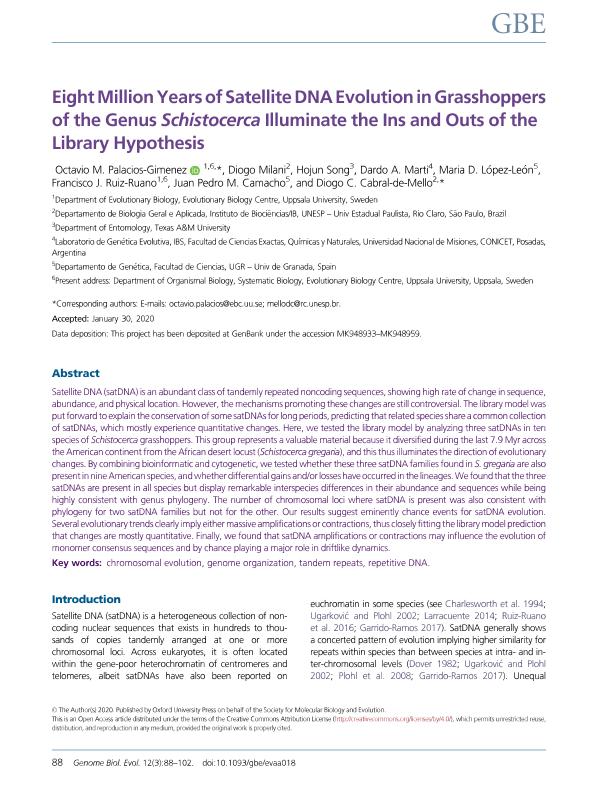Mostrar el registro sencillo del ítem
dc.contributor.author
Palacios-Gimenez, Octavio M.
dc.contributor.author
Milani, Diogo
dc.contributor.author
Song, Hojun

dc.contributor.author
Marti, Dardo Andrea

dc.contributor.author
López-León, Maria D.
dc.contributor.author
Ruiz-Ruano, Francisco J.
dc.contributor.author
Camacho, Juan Pedro M.
dc.contributor.author
Cabral-de-Mello, Diogo C.
dc.date.available
2020-08-10T20:41:40Z
dc.date.issued
2020-03
dc.identifier.citation
Palacios-Gimenez, Octavio M.; Milani, Diogo; Song, Hojun; Marti, Dardo Andrea; López-León, Maria D.; et al.; Eight Million Years of Satellite DNA Evolution in Grasshoppers of the Genus Schistocerca Illuminate the Ins and Outs of the Library Hypothesis; Oxford University Press; Genome Biology and Evolution; 12; 3; 3-2020; 88-102
dc.identifier.issn
1759-6653
dc.identifier.uri
http://hdl.handle.net/11336/111371
dc.description.abstract
Satellite DNA (satDNA) is an abundant class of tandemly repeated noncoding sequences, showing high rate of change in sequence, abundance, and physical location. However, the mechanisms promoting these changes are still controversial. The library model was put forward to explain the conservation of some satDNAs for long periods, predicting that related species share a common collection of satDNAs, which mostly experience quantitative changes. Here, we tested the library model by analyzing three satDNAs in ten species of Schistocerca grasshoppers. This group represents a valuable material because it diversified during the last 7.9 Myr across the American continent from the African desert locust (Schistocerca gregaria), and this thus illuminates the direction of evolutionary changes. By combining bioinformatic and cytogenetic, we tested whether these three satDNA families found in S. gregaria are also present in nine American species, and whether differential gains and/or losses have occurred in the lineages. We found that the three satDNAs are present in all species but display remarkable interspecies differences in their abundance and sequences while being highly consistent with genus phylogeny. The number of chromosomal loci where satDNA is present was also consistent with phylogeny for two satDNA families but not for the other. Our results suggest eminently chance events for satDNA evolution. Several evolutionary trends clearly imply either massive amplifications or contractions, thus closely fitting the library model prediction that changes are mostly quantitative. Finally, we found that satDNA amplifications or contractions may influence the evolution of monomer consensus sequences and by chance playing a major role in driftlike dynamics.
dc.format
application/pdf
dc.language.iso
eng
dc.publisher
Oxford University Press

dc.rights
info:eu-repo/semantics/openAccess
dc.rights.uri
https://creativecommons.org/licenses/by/2.5/ar/
dc.subject
CHROMOSOMAL EVOLUTION
dc.subject
GENOME ORGANIZATION
dc.subject
TANDEM REPEATS
dc.subject
REPETITIVE DNA
dc.subject.classification
Genética y Herencia

dc.subject.classification
Ciencias Biológicas

dc.subject.classification
CIENCIAS NATURALES Y EXACTAS

dc.title
Eight Million Years of Satellite DNA Evolution in Grasshoppers of the Genus Schistocerca Illuminate the Ins and Outs of the Library Hypothesis
dc.type
info:eu-repo/semantics/article
dc.type
info:ar-repo/semantics/artículo
dc.type
info:eu-repo/semantics/publishedVersion
dc.date.updated
2020-08-05T15:19:37Z
dc.identifier.eissn
1759-6653
dc.journal.volume
12
dc.journal.number
3
dc.journal.pagination
88-102
dc.journal.pais
Reino Unido

dc.description.fil
Fil: Palacios-Gimenez, Octavio M.. Uppsala Universitet; Suecia
dc.description.fil
Fil: Milani, Diogo. Universidade Estadual Paulista Julio de Mesquita Filho; Brasil
dc.description.fil
Fil: Song, Hojun. Texas A&M University; Estados Unidos
dc.description.fil
Fil: Marti, Dardo Andrea. Consejo Nacional de Investigaciones Científicas y Técnicas. Centro Científico Tecnológico Conicet - Nordeste. Instituto de Biología Subtropical. Instituto de Biología Subtropical - Nodo Posadas | Universidad Nacional de Misiones. Instituto de Biología Subtropical. Instituto de Biología Subtropical - Nodo Posadas; Argentina
dc.description.fil
Fil: López-León, Maria D.. Universidad de Granada; España
dc.description.fil
Fil: Ruiz-Ruano, Francisco J.. Uppsala Universitet; Suecia
dc.description.fil
Fil: Camacho, Juan Pedro M.. Universidad de Granada; España
dc.description.fil
Fil: Cabral-de-Mello, Diogo C.. Universidade Estadual Paulista Julio de Mesquita Filho; Brasil
dc.journal.title
Genome Biology and Evolution
dc.relation.alternativeid
info:eu-repo/semantics/altIdentifier/doi/http://dx.doi.org/10.1093/gbe/evaa018
dc.relation.alternativeid
info:eu-repo/semantics/altIdentifier/url/https://academic.oup.com/gbe/article/12/3/88/5811468
Archivos asociados
